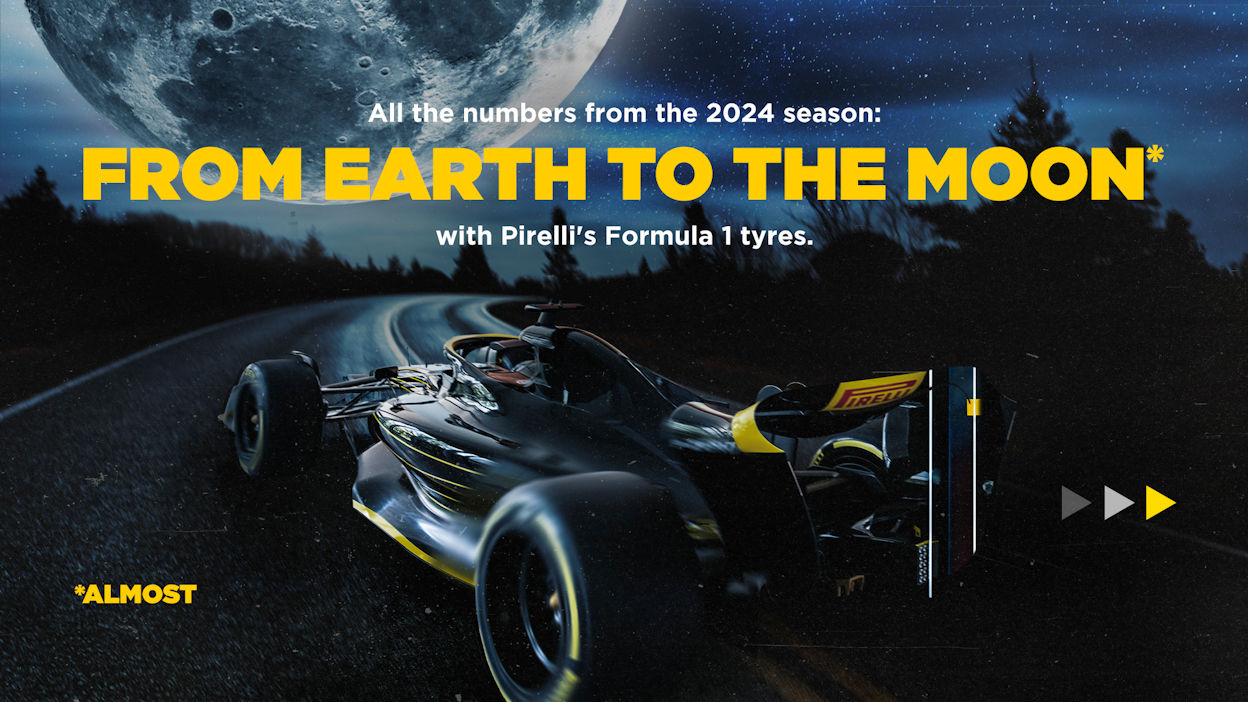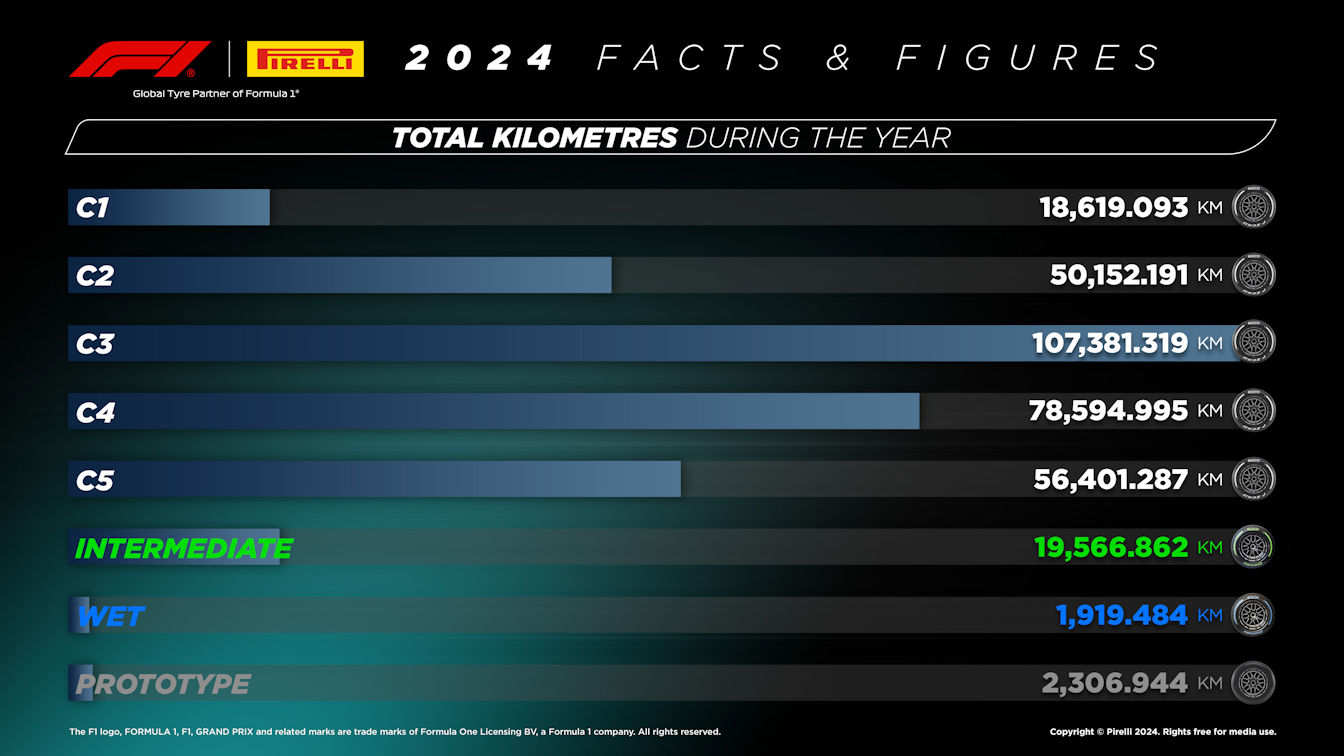The USA is headed back to the Moon in a couple of years and several other countries have landed vehicles on the lunar surface. Pirelli hasn’t been there and – as far as we know – isn’t planning a mission, but the Italian brand comments that the Pirelli tyres used over the course of the 24 Grands Prix in this longest ever Formula 1 season covered a distance that almost would reach the Moon “on an imaginary road linking our planet to its only natural satellite.”
The tyres completed a total of 334,942.175 kilometres or 208,123.419 miles during over 65,534 laps from the first free practice session in Bahrain to the chequered flag in Abu Dhabi. This is, says Pirelli, 94 per cent of the distance separating us from the Moon’s perigee, its nearest point to earth during its 27-day orbit of Earth.
Extra races, more miles
More miles were covered than in 2023 thanks to the addition of the Emilia-Romagna and Chinese Grands Prix to this year’s calendar. These accounted for an extra 27,016.375 kilometres or 16,787.197 miles. The percentage of miles completed on slick tyres remained pretty much unchanged, at 93.59 per cent, while there was an increase in use of the Cinturato Intermediate, from 5.67 per cent to 5.84 per cent, for a total of 19,566.862 kilometres or 12,158.284 miles. Cinturato Extreme Wet usage was slightly lower in the 2024 season, going from 0.64 per cent to 0.57 per cent.
Of the slicks, the lion’s share inevitably was down to the C3, with this compound selected for every event, even though in percentage terms it dropped from 36.57 per cent to 32.06 per cent compared to last year. Once again, the C4 was the second most used compound (23.47 per cent) while for third place, at 16.84 per cent the C5 overtook the C2 (14.97 per cent) and the C1 was once again the least used in 2024, at 5.56 per cent. Some of these changes in the data are down to the fact that, for the races in Melbourne and Interlagos, the decision was taken to go with a softer trio of compounds than the previous year, going from C2-C3-C4 to C3-C4-C5.
Not included in the above numbers is the data relating to prototype tyres. They were used for 2,306.944 kilometres or 1,433.469 miles. This is fewer than last year, as in 2024 they were only used for the in-competition test at Mexico City, while last year they were used during Friday free practice in three events – Barcelona, Suzuka and Mexico City.
50 laps on C3 tyres
The prize for the longest stint on a single set of tyres goes to Pierre Gasly, who completed 300.150 kilometres or 186.505 miles – that’s 50 laps – in his Alpine in Baku on a set of C3s, designated as the Hard at this Grand Prix. Charles Leclerc takes the honours for the longest distance travelled on a set of C2, completing 43 laps of the Jeddah track, equivalent to 265.525 kilometres or 164.990 miles. George Russell travelled furthest on a set of C4 (256.949 kilometres or 159.661 miles, 77 laps) in Monaco, while Nico Hulkenberg completed 242.763 kilometres or 150.846 miles, 57 laps, at Zandvoort.
Yuki Tsunoda did 28 laps of the Singapore track, equivalent to 141.820 kilometres or 88.123 miles and Racing Bulls’ Japanese driver also takes the award for the longest stint on a set of intermediates (191.844 kilometres or 119.206 miles) in Montreal, while his teammate for the final six races of the season, Liam Lawson, went further than anyone (81.871 kilometres or 50.872 miles) on one set of Extreme Wets.
5,298 sets of tyres used in 2024
Pirelli supplied the teams with a total of 8,016 sets of tyres. Of these, 2,718 were never used. The extreme wet and intermediate tyres were subject to a “strip-and-fit” policy which meant that tyres fitted to rims but never used, could be stripped and refitted for use at other rounds. In 2024, this meant that around 3500 fewer tyres needed to be produced. 935 sets of slicks, equivalent to 11.66 per cent of those produced, were fitted to rims but never saw the track. In addition, a further 948 sets (11.82 per cent) completed between one and three laps: for the most part, these are sets used in qualifying or in flying lap simulations, but the issue of more efficient tyre usage during the race weekend remains on the table.
Of all the 2024 races, the Japanese Grand Prix saw the most tyre changes: there were 46 pit stops in Suzuka. While at the other end of the scale, there were only 19 pit stops in Jeddah. Actually, the quietest Sunday in terms of action in pit lane was in Monaco, where thanks to a red flag on the opening lap, all the drivers were able to make the obligatory change of compound during the interruption, so that after that, there were only a further seven pit stops.
If there was a prize for the hottest race of the year, at least in terms of air temperature, it would go to Interlagos, with 35.6 °C recorded during Sunday’s race. In contrast, Silverstone’s temperatures ranged from 10.9 °C, rising to 13.9 °C in the race. As for track temperatures, there were some old favourites and some newcomers compared to 2023: the prize for the hottest goes to the Hungaroring with 58.6 °C, although the race in Imola saw a surprising 52.5 °C. The coldest bit of track overall was Silverstone (12.8 °C) while during a race, Las Vegas was coldest at 16.8 °C.












